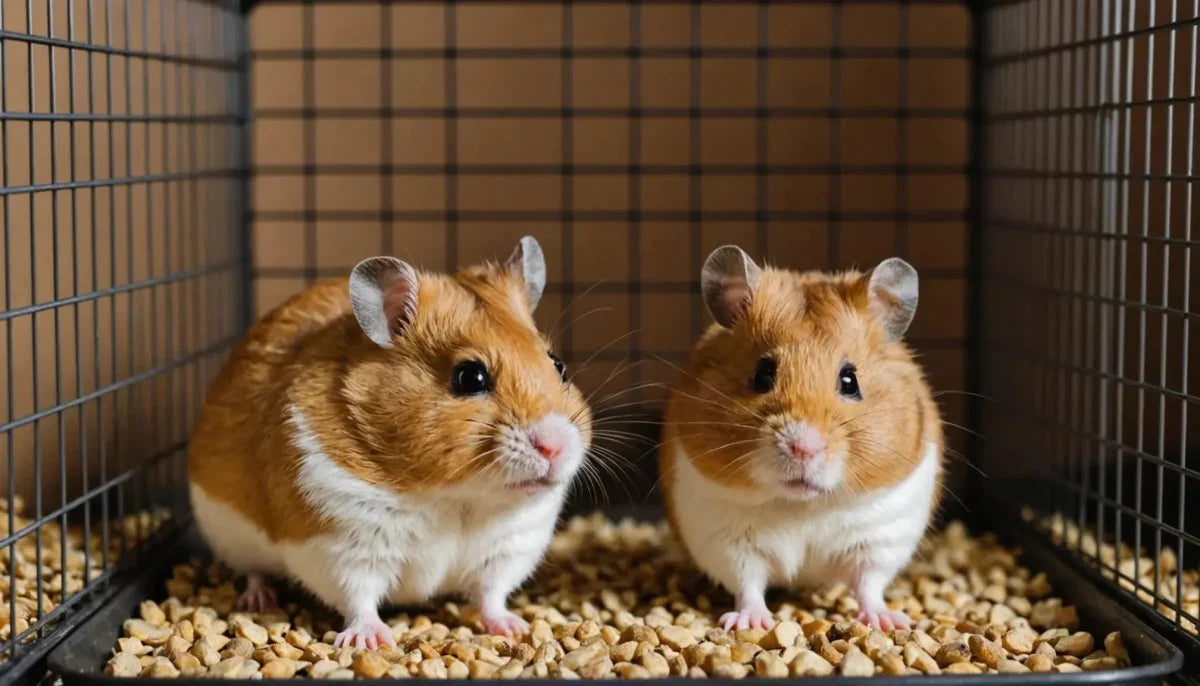Welcome to the world of hamster care!

Choosing the right cage for your furry friend is crucial for their well-being and happiness. In this guide, we will explore everything you need to know about hamster cages - from size and materials to accessories and maintenance. Your hamster's cage is their kingdom, their safe haven, and their playground. By understanding the importance of selecting the perfect home for your hamster, you are taking the first step towards providing them with a comfortable and enriching environment. So, let's dive in and discover the ideal hamster cage that will keep your pet healthy, active, and content!.
Choosing the Right Hamster Cage
When it comes to choosing a hamster cage, there are several crucial factors that need to be taken into consideration to ensure the well-being and happiness of your tiny companion. Let's explore in detail the essential aspects that should guide your decision:.
Size and Space Requirements
- Size and Space Requirements: One of the primary considerations when selecting a hamster cage is the size and space it offers. Hamsters are active creatures that require ample room to roam, exercise, and exhibit their natural behaviors. It is vital to choose a cage that provides sufficient space for your hamster to move around comfortably. Additionally, consider the breed of your hamster, as different breeds may have varying space requirements. Larger breeds, such as Syrian hamsters, generally need more space to thrive compared to their smaller counterparts. Providing multiple levels or platforms within the cage can also enhance the living space and enrichment opportunities for your pet.
Material and Construction
- Material and Construction: The material and construction of the cage play a significant role in ensuring the safety and durability of the habitat. Opt for cages made from non-toxic and sturdy materials that can withstand the chewing and digging habits of hamsters. Wire cages with narrow spacing between bars are a popular choice, as they provide proper ventilation and visibility. However, ensure that the wire coating is safe for your hamster and that there are no sharp edges that could potentially injure your pet. Alternatively, aquarium tanks with secure mesh lids can also serve as suitable enclosures, offering a clear view of your hamster while containing bedding and substrate effectively.
Safety Features
- Safety Features: Prioritizing the safety of your hamster is paramount when choosing a cage. Select a cage with secure latches and doors to prevent any accidental escapes. Check for any gaps or openings that could trap your hamster or pose safety hazards. Avoid cages with wire flooring, as it can lead to foot injuries and discomfort for your pet. Provide a solid base or add a suitable bedding material to ensure a comfortable and safe environment for your hamster to explore. Regularly inspect the cage for any wear and tear, and promptly address any potential safety concerns to maintain a secure habitat for your furry friend.
Easy to Clean and Maintain
- Easy to Clean and Maintain: Keeping your hamster's cage clean is essential for promoting good hygiene and a healthy living environment. Look for cages that feature removable trays or easy-access doors that facilitate cleaning and bedding replacement. Consider the ease of disassembly and cleaning when selecting a cage to streamline your maintenance routine. Regularly spot-clean the cage, replace bedding as needed, and sanitize the habitat to prevent odors and bacterial buildup. By maintaining a clean and well-maintained cage, you can ensure a comfortable and hygienic space for your hamster to thrive.
Choosing the right hamster cage involves careful consideration of various factors to create a safe, spacious, and stimulating environment for your pet. By prioritizing size and space requirements, selecting suitable materials, ensuring safety features, and focusing on ease of maintenance, you can provide your hamster with a cozy and secure home where they can exhibit their natural behaviors and live a happy, healthy life.
Types of Hamster Cages
When it comes to providing a comfortable and safe living environment for your furry friend, choosing the right cage is crucial. There are several types of hamster cages available in the market, each with its own set of features and benefits. Let's explore the various options:.
Wire Cages
Wire cages are a popular choice among hamster owners due to their durability and excellent ventilation. These cages typically feature a sturdy wire frame with a plastic base, offering a secure and well-ventilated space for your hamster to thrive. Available in a range of sizes, wire cages are suitable for different hamster breeds and allow for easy interaction with your pet.
Plastic Cages
Lightweight and easy to clean, plastic cages are another popular option for housing hamsters. These cages often come with multiple levels and accessories, such as exercise wheels and tunnels, to keep your hamster entertained and active. While providing a secure and comfortable living space, plastic cages also offer visibility, allowing you to observe your pet's behavior and well-being.
Glass Aquariums
While less common, glass aquariums can also serve as hamster cages. With their transparent design, glass aquariums offer excellent visibility, allowing you to enjoy watching your hamster explore its habitat. However, proper ventilation is essential when using a glass aquarium as a hamster cage to prevent respiratory issues. Ensure adequate airflow by providing ventilation holes and a wire mesh cover.
DIY Cages
For those with a creative flair, DIY cages provide an opportunity to design a customized living space for your hamster. From repurposed storage bins to homemade wooden enclosures, the possibilities are endless when it comes to DIY hamster cages. Customizing the cage based on your hamster's specific needs and your preferences can create a unique and enriching environment for your pet.
When choosing a hamster cage, consider the following factors:.
Size
Ensure the cage is spacious enough to accommodate your hamster's activities. Hamsters are active creatures that require room to explore, exercise, and rest comfortably.
Ventilation
Proper airflow is essential to maintain a healthy environment within the cage. Good ventilation helps prevent moisture buildup, which can lead to mold and respiratory problems.
Accessibility
Choose a cage that allows easy access for cleaning and interacting with your hamster. Accessibility is key to maintaining hygiene and fostering a bond with your pet.
Enrichment Opportunities
Include toys, tunnels, exercise wheels, and hiding spots in the cage to provide enrichment and mental stimulation for your hamster. These additions help prevent boredom and promote your hamster's overall well-being.
By considering these factors and selecting the most suitable type of cage for your hamster, you can ensure that your pet has a happy, healthy, and enriching living space. Whether you prefer a wire cage, plastic cage, glass aquarium, or a DIY creation, prioritize your hamster's comfort and well-being above all else.
Setting Up the Hamster Cage
Choosing Suitable Bedding and Nesting Materials
When setting up your hamster's cage, the choice of bedding and nesting materials plays a crucial role in ensuring your pet's comfort and well-being. Opt for soft, dust-free options like aspen shavings, paper-based bedding, or specialized hamster bedding. It's essential to provide a generous layer of bedding, at least 2-3 inches deep, to allow your hamster to burrow, create nests, and exhibit natural behaviors.
Strategic Placement of Food and Water Containers
The strategic placement of food and water containers is vital for maintaining your hamster's health and hygiene. Ensure that the containers are securely attached to prevent accidental spills and contamination. Position the water bottle at a height that is easily accessible to your hamster, considering their size and mobility. Likewise, place the food dish in a stable location to prevent tipping and ensure convenient access for your pet.
Enrichment Through Toys and Accessories
Enriching your hamster's environment with a variety of toys and accessories is essential for promoting physical activity and mental stimulation. Introduce engaging items such as exercise wheels, tunnels, chew toys, and hideouts to keep your hamster entertained and active. Rotating these toys regularly not only prevents boredom but also provides a dynamic and stimulating environment for your furry companion.
Creating a Safe and Stimulating Habitat
In addition to the basics of bedding, food, and toys, consider the overall safety and stimulation of your hamster's habitat. Include items like tunnels for exploration, platforms for climbing, and houses for resting. Ensure that all accessories are made of safe materials, free from sharp edges or small parts that could be ingested. Regularly inspect the cage for wear and tear, and replace any damaged items promptly to maintain a secure environment.
Proper Ventilation and Temperature Regulation
Another critical aspect of setting up your hamster's cage is ensuring proper ventilation and temperature regulation. Hamsters are sensitive to extreme temperatures, so place the cage in a draft-free area away from direct sunlight and drafts. Monitor the temperature regularly, aiming for a range of 65-75°F (18-24°C), and provide additional bedding or a heat source in colder climates.
Socialization and Interaction
Hamsters are social animals that benefit from interaction with their owners. Spend time each day handling and playing with your hamster to build trust and strengthen your bond. Gentle and consistent handling can help your hamster feel secure and reduce stress, leading to a happier and more sociable pet.
Health Monitoring and Veterinary Care
Regularly monitor your hamster's health by observing their eating habits, activity levels, and overall demeanor. Any changes in behavior or appearance should be promptly addressed by a qualified veterinarian specializing in exotic pets. Establishing a relationship with a vet experienced in hamster care ensures timely medical intervention and preventive healthcare to keep your furry friend healthy and thriving.
By incorporating these additional aspects into the setup of your hamster's cage, you can create a holistic and enriching environment that caters to your pet's physical, mental, and social needs, fostering a happy and healthy life for your beloved hamster.
Maintenance Tips for Hamster Cages
Why Regular Cleaning is Important
Regular maintenance of your hamster's cage is essential for ensuring the overall well-being of your furry friend. A clean environment not only prevents health issues but also contributes to your hamster's happiness and stress-free living. Moreover, proper maintenance extends the longevity of the cage and its accessories, saving you money in the long run.
Establishing a Consistent Cleaning Schedule
Setting up a regular cleaning routine is crucial in maintaining a healthy environment for your hamster. Apart from the weekly deep clean, it's advisable to conduct spot-cleaning in areas where your hamster tends to create messes. This could involve changing soiled bedding promptly or cleaning areas where food is hoarded more frequently to prevent contamination.
Inspecting for Wear and Tear Regularly
Regular inspections of the cage are vital to prevent accidents and injuries to your hamster. Focus on checking the cage bars, ramps, and any movable parts that could potentially harm your pet. Timely repairs or replacements of damaged components are necessary to ensure a safe living space for your hamster.
Choosing the Right Bedding
Selecting suitable bedding is critical for your hamster's well-being. Opt for bedding materials that are safe, absorbent, and non-toxic. Avoid using cedar or pine shavings as they can be harmful to hamsters. Safer alternatives include paper-based bedding or aspen shavings, which offer comfort and safety for your pet.
Upgrading Cage Accessories
Periodically upgrading your hamster's accessories can provide mental stimulation and enrichment. Consider introducing new toys like tunnels, chew toys, or hideouts to keep your hamster engaged and prevent boredom. Rotating accessories can also help in promoting natural behaviors and physical activity.
Monitoring Your Hamster's Behavior
Regularly observing your hamster's behavior is key to identifying any potential issues with the cage or its contents. Changes in eating patterns, activity levels, or signs of stress can indicate underlying problems that require attention. Being attentive to your hamster's needs is crucial for ensuring a healthy and content pet.
Importance of Exercise and Playtime
In addition to maintaining a clean cage, providing ample opportunities for exercise and play is essential for your hamster's physical and mental well-being. Invest in a hamster wheel, tunnels, and other interactive toys to encourage activity and prevent obesity. Regular playtime outside the cage in a secure environment is also beneficial for bonding with your pet.
By incorporating these maintenance tips into your hamster care routine, you can create a nurturing environment that promotes the well-being and happiness of your beloved pet.
Conclusion
Ensuring your hamster has the perfect cage is essential for their well-being and happiness. By considering factors such as size, materials, and enrichment opportunities, you can create a comfortable and stimulating environment for your furry friend. Remember, a happy hamster is a healthy hamster, so invest the time and effort into finding the ideal home for your beloved pet.





